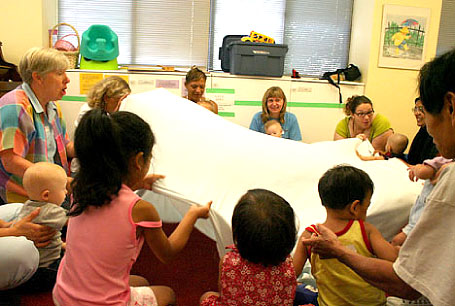
Circle time is a great opportunity for children and teachers to come together as a group and share a special time of their day. The shared experiences at circle time might include exchanging information on daily events, completing calendar and weather boards, reading a story, singing, playing games, exploring through music and movement, and much more.
All of these experiences provide children with an opportunity to develop a variety of skills such as interacting with others, sharing, taking turns, and expressing feelings. Children can also learn to pay attention, to listen and follow instructions, and to make decisions.
Circle time should be carefully planned by incorporating activities that are responsive to the children’s needs and interests, and are developmentally appropriate. The following considerations might help you to adapt your circle time.
Getting ready for circle:
- Plan the circle time as a specific part of the daily program: allow for flexibility in case of unexpected events like visitors, environmental changes, or illness.
- Discuss the circle time rules with the children: keep the rules short and simple. Use photos, line drawings or picture symbols to help describe the rules and if possible, keep them posted near the circle time area.
- If possible, implement the circle time in small groups: children who are not familiar with group activity may need to begin in small groups perhaps as small as two or three children. As children gain competence in small groups in a variety of situations, the groups can gradually be enlarged.
- Create a routine and keep it consistent: consider the number of children, time of day, duration of the activity, physical space, and hello and good-bye songs. This is especially useful with children who have difficulty dealing with changes.
During the circle:
Seating arrangements
- Have the children sit in a circle or semi-circle: this arrangement allows children to see each other and the person leading the circle.
- Ensure that all the children sit at the same level: you might want to assist a child in a wheelchair to sit on the carpet with appropriate support, or you might choose to provide chairs for the other children to sit on.
- Become part of the circle by sitting at the children’s level.
- Ensure a space for each child in the group: use individual mats, or any kind of visual/tactile sign like tape or rubber to define the individual space. Allow for about one foot of space between each child.
- Provide a variety of seating accommodations: some children may require or use specialized seating, or other pieces of furniture to stay focused and involved in circle time (e.g., beanbag chair, rocking chair, rice/bean-stuffed cushion).
- Consider a child’s physical position: children with hearing impairments may benefit from sitting directly across from the teacher. This can help a child see the teachers face, mouth, gestures, and signs more clearly. Children with problem behaviours may also benefit from sitting close to the teacher to stay focused and participate in activities.
Accommodating the Needs of the Children
- Eliminate distractions: ensure that other toys near the circle time area are put away. Cover toy shelves if needed.
- Use fidget toys: some children might need extra support to relax and stay focussed. Consider providing a child with a fidget toy to hold or squeeze (e.g., squishy balls, small bean bags, twisty snakes, stuffed animals) during this time.
- Use visual supports: use picture symbols to facilitate choice making, or introducing activities especially with songs and games. Create a song board with pictures that represent the various song choices and have the children select the next song to sing.
- Keep it short: avoid activities that require sitting and listening for an extended period of time.
- Try to ignore small disruptions.
Using Props, Materials, and Resources
- Use props and materials as part of your planned circle time activities (e.g., puppets for a story, toys or objects for a song, scarves for creative movement). Let the children use the props as much as possible. This will help them to take part in the activity and to focus for a longer period of time.
- Keep all the circle time materials and props in a bin. Rotate the materials in the bin on a regular basis to stimulate the children’s ongoing interest.
Consider making circle time a more focused and important aspect of your program as all children enjoy music and movement. Remember, above all to have fun.
REFERENCES:
Gould, P. & Sullivan, J. (1999). The inclusive early childhood classroom: Easy ways to adapt learning centres for all children. Gryphon House Inc.
Lerach, H. (1990). Storytime handbook for daycare workers. Regina Public Library.
Mulligan, S. et. al. (1992). Integrated child care: Meeting the challenge. Communication Skill Builders, Tucson, Arizona.
